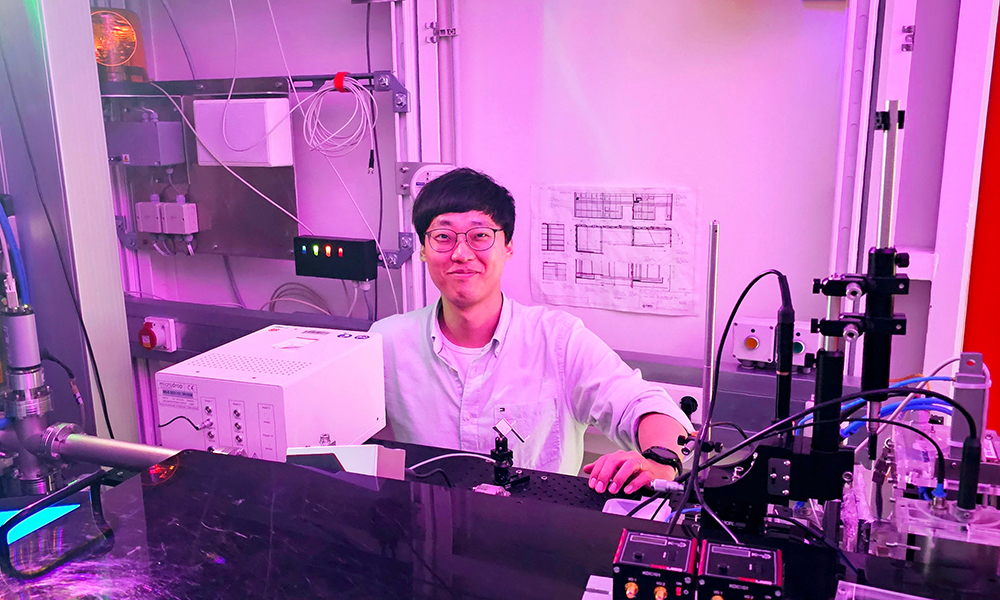
Read the latest Issue
Sihyun Sung, Postdoctoral Fellow at EMBL Hamburg, explains how time-resolved serial X-ray crystallography enables him to capture molecules in motion

Time-resolved structural biology is an approach that aims at understanding in detail how molecules change their structure over time. While being more challenging than traditional static structural biology, time-resolved structural biology is rapidly developing thanks to new emerging technologies.
EMBL Hamburg has several highly advanced time-resolved structural biology techniques, also offered as services. One of them is time-resolved serial X-ray crystallography (TR-SSX) available at EMBL Hamburg’s beamlines P14 and P14.EH2 (T-REXX).
Sihyun Sung, Postdoctoral Fellow in the Wilmanns Group at EMBL Hamburg, frequently uses TR-SSX for his work. Here, he talks about how the technique enabled him to produce molecular movies revealing how enzymes work.
One of the most captivating facets of TR-SSX research is its unparalleled ability to seize the very heartbeat of dynamic processes at the atomic level, offering profound insights into the intricate mechanisms governing biological and chemical systems. This ground-breaking technique has emerged as a catalyst for progress across diverse realms of science and technology. It holds the promise to unlock age-old scientific enigmas, answering questions that are beyond the reach of static structural data.
By delving into molecular dynamics through TR-SSX, scientists are empowered to pinpoint precise structural transformations within molecules. This newfound knowledge holds immense promise for the identification of disease-related structural alterations, opening avenues for innovative therapeutic strategies. In essence, TR-SSX is charting a course towards ground-breaking discoveries and the advancement of science and medicine.
Engaging diverse team members in time-resolved X-ray serial crystallography endeavours embodies a collaborative and interdisciplinary approach. EMBL Hamburg’s Wilmanns and Schneider Groups, in conjunction with the Hamburg Advanced Research Centre for Bioorganic Chemistry’s Mehrabi, Schulz, and Pearson Groups, have forged a longstanding partnership marked by their collective efforts, notably in the specialised setup for time-resolved experiments with crystallography (T-REXX). This equipment allows for the execution of time-resolved crystallography experiments conducted at room temperatures.
The success of time-resolved X-ray serial crystallography projects hinges upon effective collaboration and seamless communication among these expert staff members. Interdisciplinary teams, by pooling their expertise, can tackle intricate research queries, thereby pushing the boundaries of our comprehension of dynamic molecular processes. Furthermore, keeping abreast of the latest developments in X-ray crystallography techniques and technologies remains imperative for all staff engaged in this dynamic field. This ensures that they remain at the forefront of innovation, propelling scientific discovery to new heights.
In my view, what’s particularly great is that EMBL offers the prospect of engaging in pioneering research, delving into interdisciplinary collaboration, and contributing substantively to the realm of molecular biology and beyond. It’s a place where world-class research flourishes, exceptional colleagues abound, and the potential for profound contributions to the scientific community thrives – making EMBL an environment where professional dreams can truly take flight.
In my spare time, my friends and I partake in a cherished tradition we fondly call ‘Dinner Tonight’. These gatherings have become a fantastic way for us to reconnect, unwind, and relish some delectable cuisine together. Each of us takes turns presenting our home-style dishes for the evening – in my case, South Korean dishes. I personally enjoy adding a touch of international flair to our culinary adventures.
These gatherings serve as a feast not only for our taste buds but also for our friendships. They offer an opportunity to forge deeper connections, offer support during life’s highs and lows, and craft enduring memories. Our ‘Dinner Tonight’ is a genuine reflection of the strong bond we share as friends.
As a scientist, my wellspring of inspiration is a rich and intricate tapestry, woven together from diverse and multifaceted sources. At its core, this inspiration is a fusion of curiosity, exploration, collaboration, and an unwavering quest to unravel the mysteries of the world and tackle pressing problems. It’s a journey where I draw from a myriad of fountains, each contributing to my unyielding passion for discovery and innovation. It is the pursuit of answers to profound questions and the relentless quest to solve pertinent problems that kindle the flames of inspiration, propelling science ever forward.
Looking for past print editions of EMBLetc.? Browse our archive, going back 20 years.
EMBLetc. archive